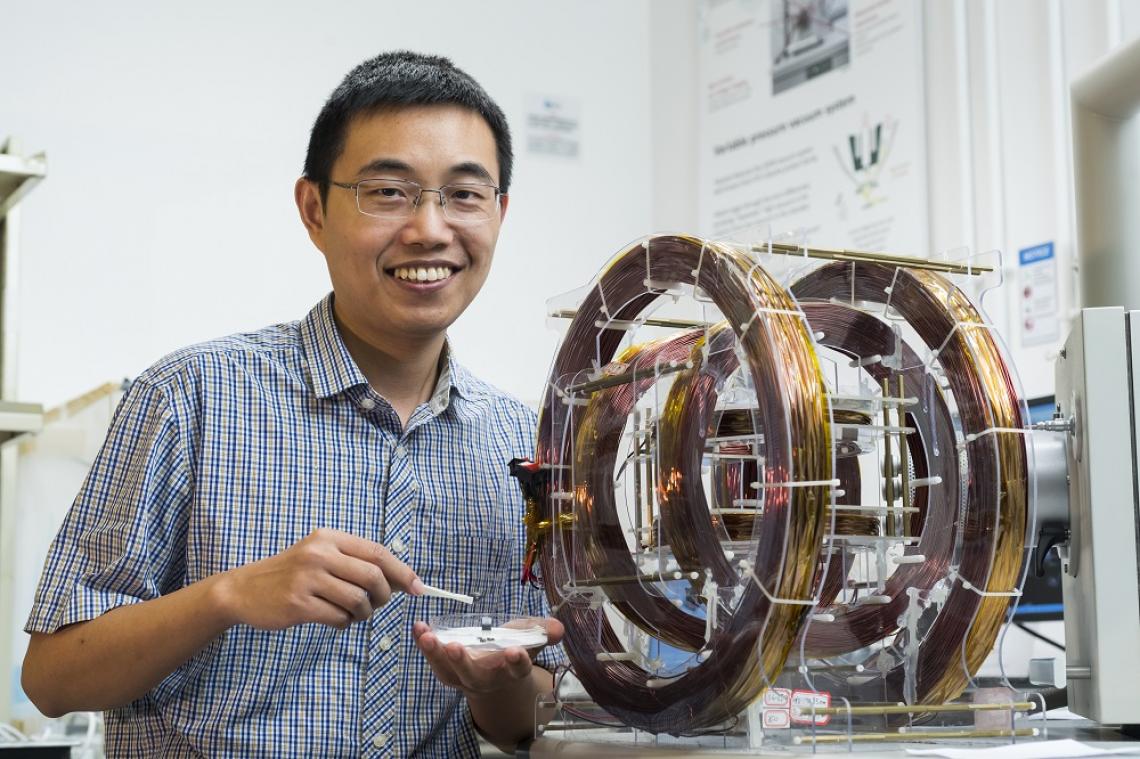Dr Shen Yajing, Associate Professor at CityU’s Department of Biomedical Engineering (BME) was one of the co-leaders of the study. The findings have been recently published in the scientific journal Science Robotics, titled “Soft magnetic skin for super-resolution tactile sensing with force self-decoupling”.
Mimicking human skin characteristics
A main characteristic of human skin is its ability to sense the shear force, meaning the force that makes two objects slip or slide over each other when coming into contact. By sensing the magnitude, direction and the subtle change of shear force, our skin can act as feedback and allow us to adjust how we should hold an object stably with our hands and fingers or how tight we should grasp it.
To mimick this important feature of human skin, Dr Shen and Dr Pan Jia, a collaborator from the University of Hong Kong (HKU), have developed a novel, soft tactile sensor. The sensor is in a multi-layered structure like human skin and includes a flexible and specially magnetised film of about 0.5mm thin as the top layer. When an external force is exerted on it, it can detect the change of the magnetic field due to the film’s deformation. More importantly, it can “decouple”, or decompose, the external force automatically into two components – normal force (the force applied perpendicularly to the object) and shear force, providing the accurate measurement of these two forces respectively.
“It is important to decouple the external force because each force component has its own influence on the object. And it is necessary to know the accurate value of each force component to analyse or control the stationary or moving state of the object,” explained Yan Youcan, PhD student at BME and the first author of the paper.
Deep learning enhanced accuracy
Moreover, the senor possesses another human skin-like characteristic – the tactile “super-resolution” that allows it to locate the stimuli’s position as accurate as possible. “We have developed an efficient tactile super-resolution algorithm using deep learning and achieved a 60-fold improvement of the localisation accuracy for contact position, which is the best among super-resolution methods reported so far,” said Dr Shen. Such an efficient tactile super-resolution algorithm can help improve the physical resolution of a tactile sensor array with the least number of sensing units, thus reducing the number of wirings and the time required for signal transmitting.
“To the best of our knowledge, this is the first tactile sensor that achieved self-decoupling and super-resolution abilities simultaneously,” he added.
Robotic hand with the new sensor completes challenging tasks
By mounting the sensor at the fingertip of a robotic gripper, the team showed that robots can accomplish challenging tasks. For example, the robotic gripper stably grasped fragile objects like an egg while an external force trying to drag it away, or threaded a needle via teleoperation. “The super-resolution of our sensor helps the robotic hand to adjust the contact position when it grasps an object. And the robotic arm can adjust force magnitude based on the force decoupling ability of the tactile sensor,” explained Dr Shen.
He added that the sensor can be easily extended to the form of sensor arrays or even continuous electronic skin that covers the whole body of the robot in the future. The sensitivity and measurement range of the sensor can be adjusted by changing the magnetisation direction of the top layer (magnetic film) of the sensor without changing the sensor’s thickness. This enabled the e-skin to have different sensitivity and measurement range in different parts, just like human skin.
Also, the sensor has a much shorter fabrication and calibration processes compared with other tactile sensors, facilitating the actual applications.
“This proposed sensor could be beneficial to various applications in the robotics field, such as adaptive grasping, dextrous manipulation, texture recognition, smart prosthetics and human-robot interaction. The advancement of soft artificial tactile sensors with skin-comparable characteristics can make domestic robots become part of our daily life,” concluded Dr Shen.
Dr Shen previously developed a novel magnetic spray that can transform objects into millirobots for biomedical applications. (Photo source: City University of Hong Kong)
Dr Shen and Dr Pan are the corresponding authors of the paper. CityU team members include PhD students Yan Youcan and Hu Zhe from BME and Dr Yang Zhengbao, Assistant Professor from the Department of Mechanical Engineering. Other collaborating researchers are from Carnegie Mellon University and the Southern University of Science and Technology.
The research was funded by the National Natural Science Foundation of China, Hong Kong Research Grant Council and Shenzhen (China) Key Basic Research Project.
DOI number: 10.1126/scirobotics.abc8801
Related story: Novel magnetic spray transforms objects into millirobots for biomedical applications



